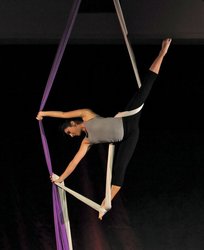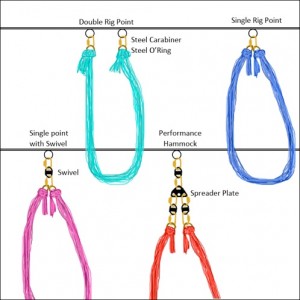

When Molly Graves brought out her recycled tire tubes during my first retreat to the Marsh Studio, I knew she was a genius. Not only is this a super-awesome exercise tool, but tire tubes are recycled and free. Good for the environment, good for you! And the tire tubes make a great gift!
You can go up to any bike shop, and they’ll be happy to give you their used tubes. These are the inner tubes that go inside the outer tube, so this part doesn’t touch the road. Just ask for one that hasn’t been repaired with slime (a goo that’s used to fix flats), cut off the valve, use a nail file to shave down the ridge and you’ve got your new favorite stretch tool.
Tubes come in different sizes. Molly recommends experimentation, but be careful not to overstretch yourself or your tire tube– the rubber can snap. And just like they say at the beginning of fitness videos, be sure to consult with your doctor before you begin any exercise program.
Stretching with bicycle tire inner tubes

“Anything you can do with a theraband, you can do with this,” Molly says. “There’s a little more resistance.”
Shoulder and side stretches
Shoulder stretch
- Put your hands wide on the doubled tire tube.
- Keep shoulders engaged in sockets– you may need to spread your hands wider across the tube.
- Notice if one side is stiffer than the other.
- Molly says this a great exercise to do everyday
Full circle shoulder stretch
- Continuing with the first shoulder stretch above, make a full circle around the back, then to the front
- Notice how you breathe
- Switch directions
Sweeps

- Keep your hands on the folded tire tube as described above, but fold yourself to the floor
- Begin to “sweep” the floor with the tube, right, then left, then right, and so on.
- Begin to sweep higher– higher right, higher left, etc. You will begin to rise.
- Then begin to sweep around and behind
- Try the opposite side as well
- Have a little dance with the tire tube
Leg stretches
Hamstrings, calves and hip flexors
“It’s like being able to give yourself an extended arm,” Molly says.
- There are many ways to use the tire tube for leg stretches:
- You could double-up the band and put it on top of your foot
- You could just put one loop over your foot.
- Molly’s wrap includes the foot and ankle (see photo).
- Wrap the tire tube around your foot and ankle.
- Holding the tail of the tube, pull your leg back for a hamstring stretch.
- Next, pull it over and across your body.
- Then let it go down and out to the other side, making a semi circle.
- Switch sides.

Straddle splits



Note: The resistance in your tire tube will vary. To avoid snapping, start with a longer tire tube.
- To get into this:
- Sit with your feet together.
- Wrap the doubled tire tube across your low back.
- Put loop over one foot
- Now stretch the tube across your low back so that the other loop end can go over the other foot. There will be some resistance.
- Slowly extend one leg, then the other, until you are in a straddle split.
- You may need to adjust the tube across your low back. You should feel pretty relaxed.
- Now watch some TV.
- To come out, slowly bring in one foot, then the other, and carefully remove the tube.
Conditioning: another awesome use of tire tubes
The tubes aren’t just for stretching; they make a great conditioning tool as well. Molly says you can fill up the tire tubes with sand, knot them up, then wrap them around your waist or ankles during your rope/fabric climbs. More weight=more strength! You go girl/boy!

Lauren Blais contributed this article which was originally published at Aerial Journal (www.aerialjournal.com). I(Rebekah) thought this was simply brilliant when I read it. I went to a local bike shop, and sure enough, they had a few tubes to spare. Now, one them snapped on me within an hour of use, so definitely be careful. Next time I won’t cut off quite so much of the air insert.



